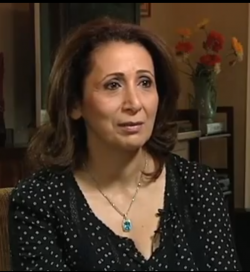Success Stories with Cellvizio
Study Finds “Virtual Biopsy” Allows Doctors to Accurately Diagnose Precancerous Pancreatic Cysts
Colombus, OH
December, 2019
Patient: Linda Bartlett, London, United Kingdom
May 2015
Linda was diagnosed with a pancreatic cyst. Her consultant gastroenterologist, Dr. Stephen Pereira, performed a Cellvizio procedure and was able to rule out cancer immediately afterwards.
“It felt like my life was on hold,” says Linda Bartlett, a 41-year-old mother of two who found out she had a cyst on her pancreas in March 2014.
Linda lives in a town called Hertford in southern England where she cares for the elderly and spends her free time gardening and cross stitching. When she began to experience abdominal discomfort that led to trouble eating and weight loss, Linda went to her doctor.
At first she thought she might be dealing with inflammatory bowel disease, but a CT scan revealed a mass on her pancreas. A subsequent MRI confirmed it was a cyst. The next step would be to determine whether it was cancerous.
“I was shocked because I thought it was cancer,” recalls Linda. “My family has a history with cancer issues. My mother is prone to cysts and my husband has had cancer. It was a stressful time.”
Linda was referred to Dr. Stephen Pereira, a consultant gastroenterologist and hepatologist at University College London. Dr. Pereira is one of the first in the UK to use endomicroscopy with Cellvizio to examine pancreatic cysts and offered Linda an opportunity to participate in a clinical study.
“The ability to rapidly and accurately diagnose pancreatic cysts is important because it reduces wait time for the patient and allows doctors to make diagnoses with more confidence,” says Dr. Pereira. “Microscopic imaging with Cellvizio during standard endoscopies allows us to see and assess individual cells in real-time.”
Linda had no prior experience with endoscopies but was willing to participate in the study.
A benign pancreatic cyst can be distinguished from a potentially malignant one by the appearance of the cyst wall. After using Cellvizio to view Linda’s cyst wall for the first time, Dr. Pereira explained that it had a supervascular network of tiny vessels which is typical of a benign cyst. The procedure took less than 30 minutes and results were instantaneous.
“Another key advantage of this technology is that patients like Linda can avoid undergoing major preventative pancreatic surgery,” adds Dr. Pereira. “In this case we were able to rule out cancer and sent Linda home. Since this is a relatively new procedure, we do follow-up with patients in a standard way while we gain more experience with Cellvizio.”
“It gave me peace of mind,” says Linda. “There may be others who are not aware of the options available when diagnosed with a pancreatic cyst. Cellvizio Targeted Biopsy helped me return to my life and continue doing the things I love doing.”
Several published clinical trials show that endomicroscopy with Cellvizio provides an accurate description of a pancreatic cyst in about eight out of ten patients. In cases where the image is not conclusive, a traditional aspiration of fluid can still be taken. A clinical study is ongoing and is currently recruiting patients from the Royal Free Hospital and University College Hospital in London as well as Addenbrooke’s Hospital in Cambridge. Soon patients will also be able to join the study at Newcastle’s Freeman Hospital and Nottingham’s Queen’s Medical Centre.
To find a physician offering Cellvizio Targeted Biopsy near you, visit https://diagnosingpancreaticcysts.com/directory/locations.
You may also wish to review a list of questions to ask your doctor about pancreatic cysts at https://diagnosingpancreaticcysts.com/patient-resources/questions-to-ask-your-doctor.php.

October 2012
Niloofar Shamloo is a painter who suddenly fell ill. She was diagnosed with inflammatory bowel disease ulcerative colitis. But doctors feared it could be the sign of something even worse, like pancreatic cancer. Using a confocal endomicroscope, doctors were able to give her a clean bill of health without having to resort to an laboratory invasive biopsy. With Cellvizio Targeted Biopsy, Niloofar Shamloo was able to go back to her painting with peace of mind.
12 million cases of cancer will be diagnosed this year. People getting biopsies for various reasons may have to wait days or more than a week to find out if they’re one of them, but a new kind of biopsy is changing that.
“I started painting five years ago,” Niloofar Shamloo told Ivanhoe. But Niloofar Shamloo’s painting was interrupted. “I was very sick, so I couldn’t continue to go to classes,” Niloofar said. In fact, she could barely move. “I had to quit my job. I had no energy. I was in bed all the time,” Niloofar said.
It was the inflammatory bowel disease ulcerative colitis. Doctors feared it could be the sign of something even worse. “Most of the time we diagnose pancreatic cancer already too late, when there is no cure,” says Michael Kahaleh, M.D., Professor of Clinical Medicine, Chief of Endoscopy and Medical Director of the Pancreas Program, Division of Gastroenterology & Hepatology, Department of Medicine at Weill Cornell Medical College, explained.
Diagnosis involves an invasive biopsy, then a stressful waiting period. Using what’s called a confocal endomicroscope, doctors can diagnose cancer cells while in the operating room, without the need for laboratory biopsies.
“A normal cell will appear under fluorescein, very clear and organized, but if it’s cancer it will be very dark and completely disorganized,” Dr. Kahaleh said. The images, magnified up to a thousand times more than a traditional endoscope, are sent to a computer where doctors can see each cell.
“The patient will leave knowing if they have cancer or not,” Dr. Kahaleh said.
Niloofar woke up from surgery and was told immediately she did not have cancer. “For me it was like a miracle,” Niloofar said. She’s back to painting with peace of mind.
Doctors are also using the scope to detect other GI tract problems, cancers in the abdomen, and colon problems. The doctor believes within the next ten years the new approach could replace traditional biopsies.
